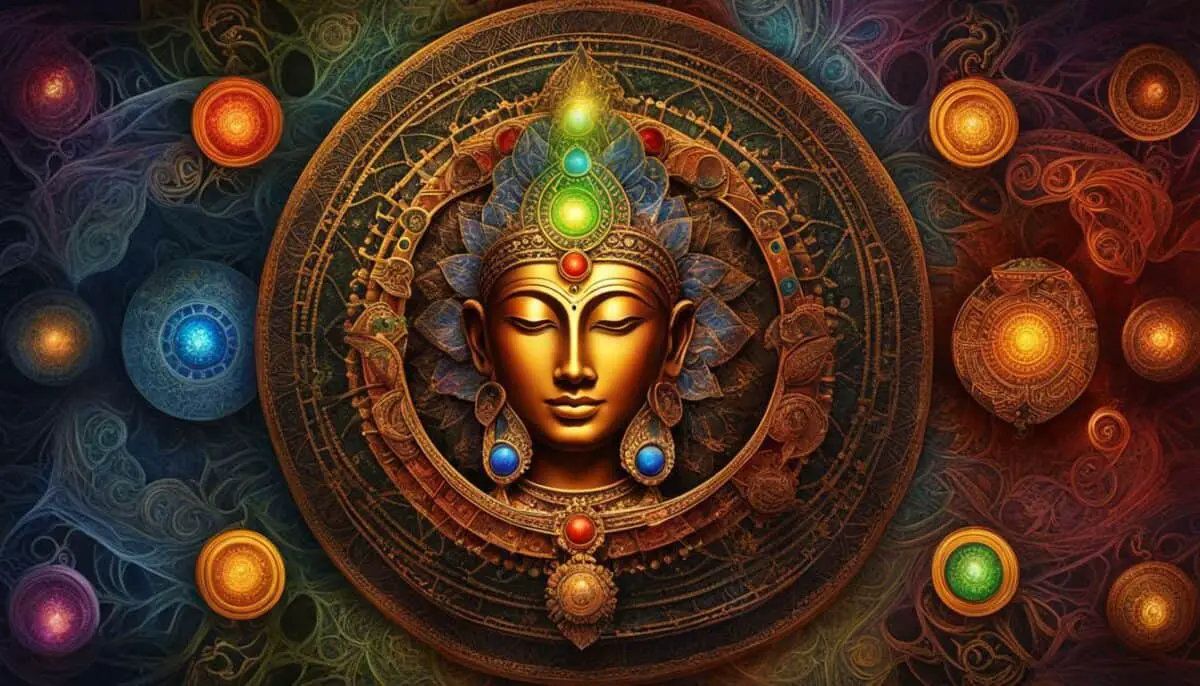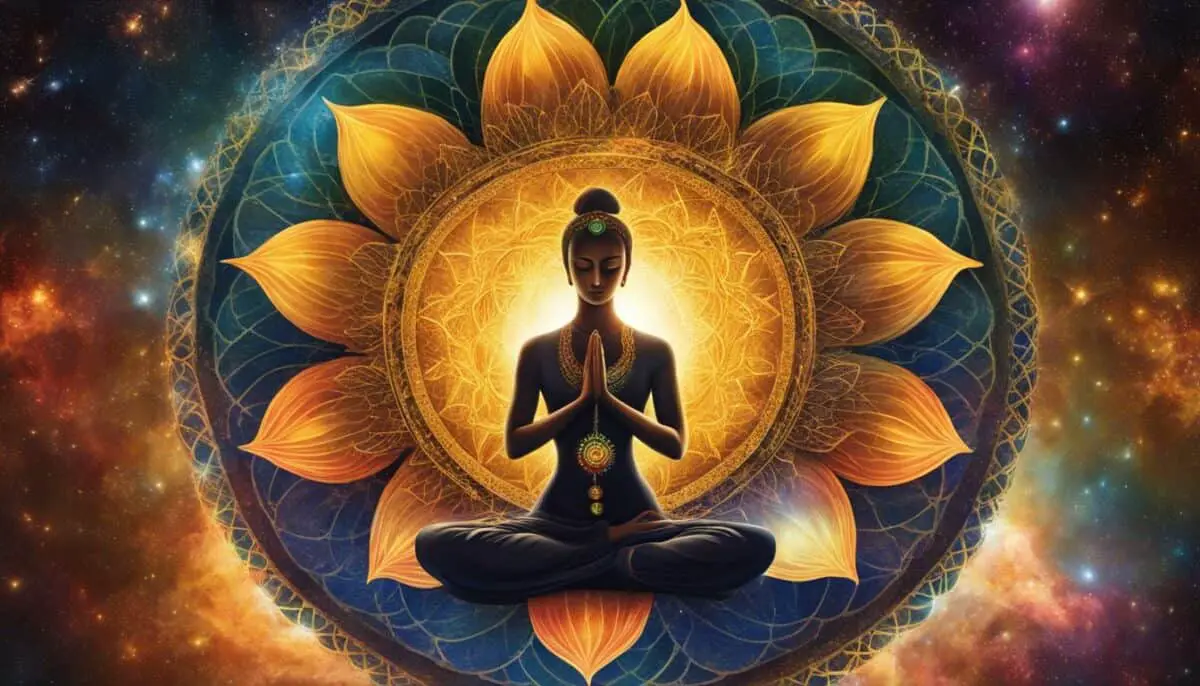In this article, we delve into the fascinating origins and history of chakras, the energy centers that have captivated the minds and spirits of individuals throughout the ages. As we explore the ancient texts and legends, we aim to shed light on the elusive question: who exactly created the concept of chakras?
Key Takeaways:
- The chakra system traces its roots back to ancient India and is mentioned in the oldest Indian scriptures known as the Vedas.
- While the Vedas do not provide information on the specific discoverer of chakras, the system was transmitted through an oral tradition by the Indo-European people.
- Various figures throughout history, such as Lord Shiva, Buddha, and Sri Amit Ray, played a role in the development and exploration of chakras.
- Ancient texts like the Vedas and Upanishads provide insights into the functions and significance of the chakra system.
- The chakra system became widely known in the West through the works of authors like Anodea Judith and Arthur Avalon.
The Development of the Chakra System
The chakra system, which plays a significant role in spirituality and holistic practices, has evolved over centuries. Exploring the origins and development of the chakra system provides insights into its rich history and the figures involved in its discovery.
Throughout history, various influential figures have contributed to the development of the chakra system. Lord Shiva, Buddha, Sri Amit Ray, Shri Gorakhnath, Purnananda Swami, Saraha, Kabir Das, Tirumular, Sir John Woodroffe, Abraham Maslow, and Carl Jung are among those who have played a role in uncovering the power and potential of chakras. Sri Amit Ray, for instance, is known for discovering the expansive 114 chakra system during deep meditation in the Himalayas, while Buddhism and Tantric Traditions incorporated the use of chakras for spiritual growth in the 8th century.
The development of the chakra system is closely tied to ancient texts, with mentions of chakras found in scriptures such as the Vedas, the Shri Jabala Darshana Upanishad, the Cudamini Upanishad, the Yoga-Shikka Upanishad, and the Shandilya Upanishad. These texts describe the chakras as spinning disks or wheels of energy running along the spine. While there are seven main chakras widely recognized, some sources suggest the existence of 114 chakras within the human body. The health and balance of these chakras are believed to impact an individual’s overall well-being, including their physical, mental, and emotional health.
| Key Figures in Chakra Development | Contributions |
|---|---|
| Sri Amit Ray | Discovered the 114 chakra system during meditation in the Himalayas |
| Buddhism and Tantric Traditions | Incorporated chakras for spiritual growth in the 8th century |
| Lord Shiva | Significant influence in the exploration and understanding of chakras |
| Abraham Maslow and Carl Jung | Explored the psychological and self-actualization aspects of the chakra system |
With the inclusion of chakra practices in yoga and other Eastern philosophies, the chakra system gained more prominence and began to spread beyond its traditional roots. Englishman Arthur Avalon’s translations of ancient Sanskrit texts, such as the Padaka-Pancaka and the Sat-Cakra-Nirupana, introduced the concept of chakras to the Western world through his book “The Serpent Power.” Today, the chakra system continues to be studied and practiced, playing a significant role in various spiritual and holistic disciplines.
The Significance of Chakra Development
The development and understanding of the chakra system provide valuable insights into the intricate connection between the mind, body, and spirit. By exploring the origins of chakras and the figures involved in their discovery, we gain a deeper appreciation for the transformative power that lies within us.
The Chakra System in Ancient Texts
The chakra system, with its roots in ancient India, is mentioned in various ancient texts that provide valuable insights into its origins, functions, and significance. One of the most notable references can be found in the Vedas, the oldest Indian scriptures dating back to 1500BC-500BC. These sacred texts describe the chakras as spinning disks or wheels of energy that run along the spine, representing different aspects of our being.
The Vedas, along with other ancient texts such as the Shri Jabala Darshana Upanishad, the Cudamini Upanishad, the Yoga-Shikka Upanishad, and the Shandilya Upanishad, provide a comprehensive understanding of the chakra system. While the Vedas themselves do not explicitly reveal who specifically discovered the chakras, they play a fundamental role in preserving and transmitting this ancient knowledge.
Ancient Origins of Chakras in the Vedas
The chakra system mentioned in the Vedas consists of seven main chakras, although some sources suggest the possibility of 114 chakras within the human body. These energy centers are believed to correlate with different physical, emotional, and spiritual aspects of our existence. The health and balance of each chakra are intricately connected to our overall well-being.
While the chakra system was traditionally part of the Eastern philosophy, it has gained recognition and popularity in the Western world as well. The teachings of the chakras have been embraced by individuals seeking spiritual growth, self-discovery, and a holistic approach to healing and well-being.

| Ancient Texts | Description |
|---|---|
| Vedas | Oldest Indian scriptures dating back to 1500BC-500BC, mentioning the chakra system and providing insights into its functions and significance. |
| Shri Jabala Darshana Upanishad | An Upanishad text that further explores the chakra system and its connection to spirituality. |
| Cudamini Upanishad | An Upanishad text that sheds light on the chakra system and its influence on individual well-being. |
| Yoga-Shikka Upanishad | An Upanishad text that elaborates on the chakra system and its role in yoga practices and spiritual growth. |
| Shandilya Upanishad | An Upanishad text that explores the chakra system and its relationship with the subtle body. |
The chakra system in ancient texts serves as a testament to its deep roots in spiritual and philosophical traditions. These texts continue to be valuable resources for those seeking to deepen their understanding and practice of the chakras.
The Influence of Yoga and Eastern Philosophy
The chakra system and yoga have a deep-rooted connection that dates back to ancient times. In yoga practices, the activation and balancing of the chakras are integral to enhancing spiritual growth and overall well-being. These energy centers, known as chakras, can be awakened and harmonized through specific yogic techniques, allowing individuals to tap into their full potential.
Initially, the concept of chakras was primarily a part of Eastern philosophy. However, it gained significant attention in the Western world through the works of Arthur Avalon, an Englishman. His book “The Serpent Power,” along with his translations of the Padaka-Pancaka and the Sat-Cakra-Nirupana, played a crucial role in introducing the chakra system to Western audiences.
Today, the chakra system is widely studied and practiced in various spiritual and holistic disciplines. It has become an integral part of yoga classes and workshops, where practitioners learn to work with their chakras to enhance their spiritual journey. By aligning and balancing the chakras, individuals can experience a deeper sense of connection, vitality, and well-being.

In summary, the chakra system and yoga are intertwined practices that hold immense significance in Eastern philosophy. Through the ancient wisdom of the chakras, practitioners can tap into their internal energy centers and explore the depths of their spiritual selves. Whether you are a seasoned yogi or a curious beginner, delving into the world of chakras can open up a new realm of self-discovery and transformation.
Conclusion
The origins of the chakra system may remain somewhat mysterious, with no specific individuals credited as the original discoverers. Instead, the chakras have been discovered and experienced by countless individuals throughout history who have found them to be useful for spiritual growth and self-discovery.
The chakra system’s significance lies in its potential to guide practitioners in harnessing specific energies and working with the subtle body. These spinning disks or wheels of energy, described in ancient texts such as the Vedas, are believed to be connected to an individual’s overall well-being, including their physical, mental, and emotional health.
Today, the chakra system continues to be a fascinating topic that invites further inquiry and understanding. As it is intertwined with practices like yoga and Eastern philosophy, the chakra system’s influence spans cultures and continents. Whether you delve into the ancient origins of the chakras or explore their significance within modern spiritual and holistic disciplines, the chakra system offers a pathway to deeper self-awareness and spiritual growth.
FAQ
Who discovered the chakras?
The origins of the chakra system can be traced back to ancient India, but there is no specific individual credited as the original discoverer. The chakras have been discovered and experienced by countless individuals throughout history.
How old is the chakra system?
The chakra system is mentioned in the oldest Indian scriptures known as the Vedas, which date back to 1500BC-500BC. However, the chakra system’s exact origins are still somewhat mysterious.
How many chakras are there?
There are seven main chakras in the human body, but some sources mention the possibility of 114 chakras. These spinning disks or wheels of energy run along the spine.
What is the relationship between yoga and chakras?
Yoga practices incorporate the activation and balancing of the chakras to enhance spiritual growth and well-being. The chakras are believed to be energy centers that can be awakened and harmonized through specific yogic practices.
Are the chakras mentioned in ancient texts?
Yes, the chakra system is mentioned in various ancient texts such as the Vedas, the Shri Jabala Darshana Upanishad, and the Yoga-Shikka Upanishad. These texts provide insights into the functions and significance of the chakras.
How did the chakra system gain popularity in the West?
The chakra system gained attention in the West through the works of authors like Anodea Judith and Englishman Arthur Avalon, who wrote “The Serpent Power” and translated important texts on chakras. Today, the chakra system is widely studied and practiced in various spiritual and holistic disciplines.



